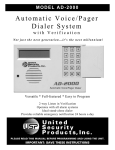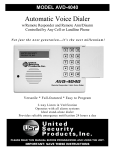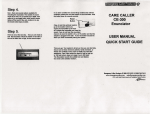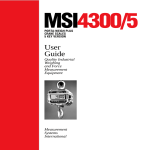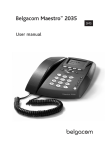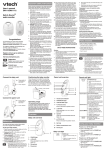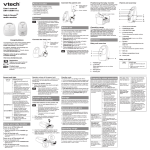Download United Security Products 10-4 Owner`s manual
Transcript
The PULL-FOR-HELP Emergency Caller Model 10-4 Automated Call for Help! System OWNER’S MANUAL AND OPERATING INSTRUCTIONS UNITED SECURITY PRODUCTS, INC. GETS HELP FAST! Federal Communications Commission Radio and Television Interference Statement for A Class ‘B’ Device This equipment generates and uses radio frequency energy and if not installed and used properly, that is, in strict accordance with the manufacturer’s instructions, may cause interference to radio and television reception. It has been type tested and found to comply with the limits for a Class ‘B’ computing device in accordance with the specifications in Subpart B of FCC Rules and Regulations (as outlined in the Code of Federal Regulation, Title 47), which are designed to provide reasonable protection against such interference in a residential installation. User Instructions: If this equipment does cause interference to radio or television reception, which can be determined by turning the equipment off, then on, the user is encouraged to try to correct the interference by one or more of the following measures: • Reorient or relocate radio or television. • Increase the separation between the equipment and receiver. • Connect the equipment into a different outlet so that the equipment and receiver are on different branch circuits. • Consult the dealer or an experienced radio/TV technician for help. Changes or modifications not expressly approved by United security Products, Inc. could void the user’s authority to operate the equipment. 2 Important! Please Read This Page Thank You for Purchasing The Emergency Caller from USP! USP has made every effort to make The Emergency Caller the finest Personal Emergency Response System on the market today. However, for your safety please take the following precautions when using The Emergency Caller: • The Emergency Caller should be tested regularly to ensure proper delivery of your pre-recorded emergency message when activated by the Pull-For-Help transmitter or the Auxiliary input. This is your responsibility as the user of the product. • Certain structures within a household may block the transmitter signal. It is up to the user to test the transmitter within the area of use to determine if dead areas exist, and where they are located. • Holding the transmitter next to your body or the ground while in use may decrease the range of the transmitter signal. • Using The Emergency Caller does not guarantee that you will contact or receive help. The Emergency Caller is only an aid to assist you in calling for help. • The transmitter should be tested frequently to protect against undetected interference or fault. • For U.S. installations only: The Emergency Caller is required to comply with Part 15 of the FCC Rules and regulations. As such, it has limited transmitter power and therefore limited range. • The dialer cannot respond to more than one transmitted signal at a time and may be blocked by radio signals that occur on or near their operating frequencies, regardless of code setting. • Changes or modifications to the device may void FCC compliance. 3 The Emergency Caller… Gets Help Fast! Congratulations! Thank you for purchasing United Security Products, Inc.’s Emergency Caller - the “smartest”, most comprehensive automatic voice/pager emergency dialer available. Representing an exciting new level of achievement, The Emergency Caller combines technologically advanced features, ease of programming and reliable operation in a compact, unobtrusive dialer. Installation and hookup are quick and easy. The unit is a stand-alone wireless device that simply connects to an ordinary telephone jack. The keypad cover glides on and off for added attractiveness and security. How It Works: The Emergency Caller features busy-line and no-answer detection to ensure prompt transmission of the prerecorded message to as many as 4 standard telephones, cellular phones, voice and/or numeric pagers. Message to both local and long-distance calls can be transmitted. When activated, the dialer instantly begins calling the numbers in sequence, in an attempt to deliver the message or pager code. The Emergency Caller is extensively programmable, offering personalized customization to fulfill virtually any residence. Plain-English prompts walk the user through the process in a timely manner. Programming options abound, allowing the user to: • Store up to 4 telephone/pager numbers. • Store an emergency message (maximum: 20 sec.). • Select Tone/Pulse dialing, Standard telephone line/PBX system and Momentary/Continuous activation. Special Features: • The dialer will “beep” every 30 seconds in the Program and Test mode. This is to warn the user that the dialer is not in the Operate or Off mode. • In the Test mode, when testing the input, the dialer will check to make sure that there is a dial tone. If no dial tone is detected, the dialer will not continue testing the input and will display: NO DIAL TONE! (Connect the dialer to the telephone line and re-test the input). Note: Although the dialer checks for a dial tone it will not actually dial out. • The dialer will check to make sure that, at least, one telephone number and OGM or one pager number is programmed before allowing the dialer to be switched to the Operate mode. If programming is not complete, the dialer will display: PROGRAMMING IS NOT COMPLETE! (After 2 seconds the dialer will automatically switch to the Programming mode). Please Familiarize Yourself With These Instructions Before Installation/Operation. This guide describes how to program and operate the dialer. We strongly recommend that you read the entire manual before attempting to use the unit. To enhance ease of programming and operation, this guide includes: • A Programming Sample/Quick Setup review on page 20 with a corresponding Program Planner. • A Blank Program Planner on page 21. One copy of this Planner should be kept in a safe place by the end user. A separate copy should also be retained by the installer. 4 Table of Contents Section Page number Package contents………………………………………………………………… 6 Care and Precautions…………………………………………………………….. 7 Panel Displays…………………………………………………………………… 8 Installation Hookup……………………………………………………………… 9 The Pull-For-Help Transmitter………………………………………………….. 10 The Pull-For-Help Transmitter necklace………………………………………… 11 Programming The Emergency Caller……………………………………………. 12 Overview……………………………………………………………………… 12 Programming Phone/Pager Numbers…………………………………………. 13-14 Programming Auxiliary Information, OGM and Input.………………………. 15-16 Testing Your System………………………………………………………….. 17 Operating Your System and Additional Features……………………………….. 18-19 Programming Example and Sample Program Planner………………………….. 20 Blank Program Planner………………………………………………………….. 21 Weekly Test Log………………………………………………………………… 22 Specifications and Dialer Accessories..…………………………………………. 23 The Emergency Caller, by United Security Products, is a compact Personal Emergency Response System. This full-featured unit provides fast, automatic emergency notification for single residents, latch-key children, elderly people, illness sufferers and others who desire the reassurance of 24-hour peace of mind. Combined with the cordless Pull-For-Help Transmitter, The Emergency Caller will call for help even if you are unable to reach the telephone yourself! EASY • • • Fast plug-in installation Programs in minutes Activates by pressing the Auxiliary input or remotely with the cordless Pull-For-Help Transmitter VERSATILE • • Communicates with up to 4 telephones, cellular phones and/or pager destinations Can quickly change the 20-second personalized message and your programmed numbers SECURE • • • Provides automatic, emergency communication 24 hours a day Incorporates busy-line and no-answer detection, and will redial until the message is delivered Operates despite power outages with built in battery backup Important: Save These Instructions 5 Packaging Contents As you unpack your Emergency Caller, check to make sure you have the following items: 1. 2. 3. 4. 5. 6. 7. Emergency Caller Main unit Long telephone line cord Pull-For-Help Cordless Transmitter 9-12V AC/DC adaptor, with 3.5mm plug Antenna Pull-For-Help Transmitter Necklace with Stopper and Bead Instruction Manual 1 5 3 4 2 6 6 Care and Precautions WARNING: DO NOT EXPOSE UNIT TO RAIN OR MOISTURE. DO NOT OPEN HOUSING. LOCATION Place the dialer on a flat level surface or mount the unit on the wall, away from extreme cold or heat, direct sunlight, excessive humidity and away from equipment that generate strong magnetic fields. Avoid placing near large metal objects and areas that produce smoke, dust and mechanical vibrations. CARE Clean the housing with a soft cloth lightly moistened with water or mild detergent solution. Never use solvents such as alcohol or thinner. Do not allow liquids to spill into the unit. PULL-FOR-HELP TRANSMITTER BATTERIES The 3-Volt Lithium batteries (Duracell #2025 or equivalent) that are pre-installed with your Pull-For-Help Transmitter are for testing purposes only. These batteries should be replaced after purchase. Under normal use transmitter batteries should last 12-18 months. Transmitter batteries should be replaced at least once a year. OPTIONAL BACKUP To ensure continuous operation during power outages, hookup to a 12VDC backup battery pack is recommended. (PP-1) Available from United Security Products. CAUTION Do not use the dialer if a gas leak is suspected or during lightning. PROBLEMS If liquid or a foreign object penetrates the unit, disconnect it immediately and contact your installer or other qualified technician. Before calling USP, please make sure… • • • You have read this manual and understand how to operate the dialer. Your phone line is working. You check out the entire system, including external hookup wiring and sensors attached. 7 Panel Displays 8 Installation Hookup *OPTIONAL *OPTIONAL *OPTIONAL 9 T h e P u l l - F o r- H e l p T r a n s m i t t e r CAUTION: We strongly recommend that you test your cordless PullFor-Help Transmitter with The Emergency Caller frequently. From the time of installation, it is absolutely necessary to test the system at least once a week to ensure that The Emergency Caller will be ready when needed. The batteries should be replaced every year. Description The Pull-For-Help Transmitter is a digitally coded miniature radio transmitter. The Pull-For-Help Transmitter is powered by two long life, selp-contained 3-volt batteries. The transmitter is water-resistant but not waterproof. Do not immerse in water. Checkout And Test Move at least six feet away from The Emergency Caller and activate the Pull-For-Help Transmitter by pulling down on the cord attached to the bottom of the case. Emergency Caller activation indicates that the Pull-ForHelp Transmitter is operating properly and that the Pull-For-Help Transmitter’s digital code is correctly matched to The Emergency Caller. To stop testing simply return the transmitter to its original closed position. Operate the Pull-For-Help Transmitter from various locations within the area to be used. This will help to locate areas where obstacles may interfere with transmission and will identify the range on the transmitter. Changing The Batteries To replace the batteries in your Pull-For-Help Transmitter you need 2, 3-volt Lithium batteries (Duracell #2025 or equivalent). First be sure to disconnect the dialer from the telephone line. Carefully remove the screws on the transmitter case. Remove the clip from the transmitter case and separate the transmitter housing. Carefully remove the circuit board inside, and avoid touching any of the components. Remove the old batteries from the battery clip, and place the new batteries under the clip with the positive ends of both batteries facing up. Place the circuit board back in the transmitter housing, and reassemble the transmitter case. After changing the batteries be sure to reconnect the phone line and test the Pull-For-Help Transmitter to make sure you have installed the batteres properly. 10 T h e P u l l - F o r- H e l p T r a n s m i t t e r N e c k l a c e The Pull-For-Help Transmitter necklace was designed with your safety in mind. If for some reason the necklace catches on something it has a release feature so you will not be injured. In addition, the necklace has an adjustable bead that will comfortably secure the necklace around your neck so it cannot fall off during normal everyday activities such as bending over, as well as during an accident or fall. The length of the necklace is adjustable so you can customize it to your ideal size for a comfortable fit. Adjusting The Length To adjust the length of your Pull-For-Help Transmitter Necklace simply depress the button on the necklace stopper and slide the necklace cord through the hole to the length you desire. When the correct size is obtained simply release the stopper button. Adjusting The Necklace Bead To make sure the necklace will not fall off during everyday activities or in case of an accident, slide the necklace bead toward your head until the loop around your neck will not easily slip off. Do not adjust the bead too tight, the necklace should remain loose and comfortable. You can adjust the bead to an ideal comfortable fit. Quick Release Feature If for some reason the necklace becomes caught on an object, the necklace will release when enough pressure is applied. When enough pressure is applied the necklace cord will slide through the stopper allowing the necklace to separate and avoid any injury to the wearer. To reconnect the necklace simply depress the stopper button and slide the ends of the necklace through the stopper hole. When the desired size is reached simply release the stopper button. Important: Never tie a knot in the necklace, as this will prevent the emergency necklace feature from functioning. 11 Programming The Emergency Caller Overview Please study this section thoroughly before beginning to program the dialer, referring to the Sample Program Planner on page 20. Then, select from among the options for each feature, listing each choice in pencil on the blank Program Planner on page 21. Once the dialer is correctly programmed, list each choice in ink. One copy of the Planner should be kept by the installer; one copy should remain with the end user. A look At The Keypad • CALLOUT FOR NUMERALS: Press these keys to enter telephone numbers and other programming information as specified in this manual. A maximum of 28 digits can be input in each phone/pager location. • CALLOUT FOR P: Press this key to program in a pause. Each “P” provides a 2-second pause. • CALLOUT FOR R: Press this key to record the directional outgoing messages (OGMs). The total elapsed OGM time cannot exceed 20 seconds. • CALLOUT FOR M: Press this key to change the Mode of the dialer, in sequence: PROGRAM TEST OPERATE OFF. Once the unit has been programmed, removing power or placing the dialer in the OFF mode will not affect the programming. 12 Programming The Emergency Caller First Time Installation to Initialize Dialer Follow Steps 1 & 2. STEP 1 Apply power to the unit. The LCD will read: STEP 2 Press 1. The LCD will change to read: NOT PROGRAMMED PRESS KEYPAD #1 EMERGENCY CALLER USP (REVISION) then: PROGRAM: NUMBERS then: SELECT: 1-4 0(DONE) Programming Telephone And/Or Pager Numbers You are now ready to begin programming the dialer. All programming can be input before connecting the dialer to a telephone line. Check the unit’s LCD as you program numbers in the dialer to ensure accuracy. Please complete all programming instructions before attempting to operate the unit. Before programming your dialer to call the police, fire department or 9-1-1 directly, you must check with these agencies for their approval. A maximum of 28 digits (including pauses) can be programmed in at each location. *PROGRAM: NUMBERS SELECT: 1-4 1(YES) 2(NO ) 0(DONE) *This prompt will appear after a number has been programmed and this section has been exited. STEP 1 Press location number 1-4 to program the first number. This can be any location 1-4. You do not have to program locations in sequence. For example, you can program numbers in locations 2 and 4. When you are done programming all the desired telephone and/or pager numbers, press “O” to exit this section. The LCD will read: PAGER 1(YES) 2(NO) STEP 2 Press “1” if you wish to program in a numeric pager number (step 3A). Press “2” if you wish to program in a telephone number (step 3B), cellular phone numer (step 3B), or a voice pager (step 3C). STEP 3A- NUMERIC PAGERS NOTE: WHEN PROGRAMMING NUMERIC PAGERS, YOU MUST PROGRAM IN ONE OR MORE PAUSES. EACH “P” PROVIDES A 2-SECOND PAUSE. BEFORE PROGRAMMING IN A PAGER, CALL THE NUMBER TO DETERMINE THE NUMBER OF 2-SECOND PAUSES TO BE PROGRAMMED IN. If you pressed “1” to program in a numeric pager… Press the digits of the pager to be called. The numbers will appear on the LCD, as will the following key designations. Press “P” one or more times in accordance with the number of seconds needed to accommodate the pager. (Remember, each “P” provides a 2-second pause). Press the digits of the numeric pager code. Press “*” to store the sequence. 13 Programming The Emergency Caller Example: To store numeric pager number 555-1212, a 4-second Pause and code 3456: Press: NOTE: SOME PAGER SERVICES REQUIRE A “#” SIGN FOR SEPARATION OF THE NUMERIC CODE OR AT THE END OF THE NUMERIC CODE FOR PROPER TRANSMISSION. STEP 3B – TELEPHONE NUMBERS If you pressed “2” and wish to program in a telephone number… Press the digits of the number to be dialed. For long-distance numbers, first press “1” followed by the area code and then the number. The number will appear on the LCD. Press “*” to store the sequence. Example: Store telephone number 1-800-555-1212: Press: REMEMBER/NOTE: Before programming your dialer to call the police, fire department 0r 9-1-1 directly, you must check with these agencies for their approval. STEP 3C – VOICE PAGERS If you pressed “2” and wish to program in a voice pager… Press the digits of the pager to be called. Press “P” one or more times in accordance with the number of seconds needed to accommodate the pager. (Remember each “P” provides a 2-second pause). Press “*” to store the sequence. The number will appear on the LCD. Example: To store voice pager 555-1212 and a 4-second pause: Press: STEP 4 Repeat steps 1-3 for each number to be programmed in each location. Select any of 4 location numbers in Step 1 (SELECT: 1-4) for each number to be programmed. STEP 5 When you are done programming all desired telephone and/or pager numbers, press “0” to exit this section. NOTE: IF YOU ENTER THE WRONG CHOICE, PRESS “M” KEY REPEATEDLY AND RETURN TO THE “PROGRAM MODE”, THEN SELECT THE SECTION TO CHANGE (“1” ACCEPT SECTION, “2” FOR NEXT SECTION), THEN ENTER CORRECT INFORMATION. 14 Programming The Emergency Caller Programming Auxiliary Information The dialer is preset at the factory to typical telephone line (T-LINE), Tone/Pulse and PBX options. If you choose to accept the following default prompts, simply press “2” to scroll to the next section. If your phone system requires dialing a digit to get an outside line or dial tone, similar to PBX, then turn PBX on and enter digit to program. PRESETS T-LINE…………….TONE PBX………………….OFF To change the presets, follow these steps. T-LINE The LCD will display: PBX The LCD will display: The LCD will display: Step 1: Press “1” for ON. Press “2” for OFF. Step 2: If “1” is entered, the LCD will display: PROGRAM: PBX ENTER PBX NUMBER Enter PBX number (1 digit). PROGRAM: T-LINE 1(YES) 2(NO) Press “1” to program T-LINE. Press “2” to scroll to the next section. PROGRAM: T-LINE 1(TONE) 2(PULSE) Press “1” for TONE. Press “2” for PULSE. PROGRAM: PBX 1(ON) 2(OFF) Programming And Recording Your Outgoing Message Follow these steps to program and record your outgoing message. Skip this portion if you have programmed in only numeric pagers, which rely on coded DTMF messages. As with all Emergency Caller programming, the unit need not be connected to a phone line when information is programmed in. Remember that “OGM” stands for outgoing message. Total OGM time is 20 seconds. Typically the dialer is programmed to notify family, friends or another responsible party. Before programming your dialer to call the police, fire department or 9-1-1 directly, you must check with these agencies for their approval. NOTE: IF YOU ENTER THE WRONG CHOICE, PRESS “M” KEY REPEATEDLY AND RETURN TO THE “PROGRAM MODE”, THEN SELECT THE SECTION TO CHANGE (“1” ACCEPT SECTION, “2” FOR NEXT SECTION), THEN ENTER CORRECT INFORMATION. STEP 1 Before programming, write down all your message. Time the message carefully to fit in the alotted time frame. Practice saying the message, clearly enunciating the message for maximum clarity in case of an emergency. Keep a final recording script. STEP 2 Program your OGM. A) The LCD will read: PROGRAM: OGM 1(YES) 2(NO) B) Press “1” to program your OGM. Press “2” to scroll to the next section. 15 Programming The Emergency Caller STEP 3 After selecting your option as explained above, record your message. A) The LCD will read: PRESS R B) Speak 6-12 inches away from the microphone. Referring to your script and speaking in a normal voice, press and hold R (the word RECORDING will be displayed), releasing the key after you have completed enunciating your messages. The word DONE will appear on the LCD when the maximum alotted time has been reached. C) The LCD will read: PLAY OGM 1(YES) 2(NO) Press “1” to play back your recording D) The LCD will read: ACCEPT 1(YES) 2(NO) Press “1” to accept the recorded OGM. Press “2” if you wish to re-record the message, beginning with Step 3. Changing The OGM After your system is up and operating, you may change the recorded OGM. To do so, simply scroll to the programming section on your display: PROGRAM: OGM 1(YES) 2(NO) Select the option, then begin again from Step 3 above to record your new message. Programming The Input The Emergency Caller is designed to be adaptable to a complete range of personalized applications. The input can be programmed for full system customization. In addition to setting the Tone/Pulse and Standard telephone line/PBX the user can specify the type of activation; Momentary or Continuous. NOTE: IF YOU ENTER THE WRONG CHOICE, PRESS “M” KEY REPEATEDLY AND RETURN TO THE “PROGRAM MODE”, THEN SELECT THE SECTION TO CHANGE (“1” ACCEPT SECTION, “2” FOR NEXT SECTION), THEN ENTER CORRECT INFORMATION. STEP 1 The LCD will read: PROGRAM: INPUT 1(YES) 2(NO) Press “1” to begin programming the input. STEP 2 The LCD will read: PROGRAM: MOM/CONT 1(MOM) 2(CONT) Press “1” for momentary activation. Press “2” for continuous activation PRESS “M” TO EXIT PROGRAMMING MODE. In the Program mode, a beep will be heard every 30 seconds. This is to indicate that the dialer is not in the Off or Operate mode. 16 Testing The Emergency Caller Test your system before an emergency occurs. Do not neglect to review programmed information and verify all elements of your system thoroughly before relying on the dialer to deliver the necessary information to the desired parties accurately and completely. The test mode tests the stored information, not the full functionality of the dialer. To test the full functionality of the dialer, the unit must be tested in the operate mode. In the test mode, the dialer will not make more than one attempt per number dialed or play the OGM more than once. NOTE: IF YOU ENTER THE WRONG CHOICE, PRESS “M” KEY REPEATEDLY AND RETURN TO THE “PROGRAM MODE”, THEN SELECT THE SECTION TO CHANGE (“1” ACCEPT SECTION, “2” FOR NEXT SECTION), THEN ENTER CORRECT INFORMATION. STEP 1 Press the “M” Mode key until the LCD reads: TEST: T-LINE 1(YES) 2(NO) STEP 2 Press “1” to display the T-Line configuration. The data will scroll through all selections. Press “2” to scroll to the next section. Note: To fully test the input, the dialer must be connected to a telephone line. If the dialer does not detect a dial tone, it will not continue testing the programmed numbers and will display: NO DIAL TONE! Connect the dialer to a telephone line and press the “M” key until the TEST: T-LINE prompt appears. Continue testing the input by selecting “2” in Step 1 and skip to Step 3. STEP 3 The LCD will read: TEST: INPUT 1(YES) 2(NO) STEP 4 Press “1” to test input. Verify data accuracy as the LCD scrolls through by comparing the information displayed with that specified on your Program Planner. Listen to your recorded message to ensure that the correct OGM (if programmed) is delivered. Press “2” to scroll to the next section. STEP 5 To test the operation of your entire system, set Mode to OPERATE and proceed as explained in the next section: Operating Your System. NOTE: IN ORDER TO TEST IN THE OPERATE MODE, AT LEAST, 1 PHONE NUMBER AND OGM OR 1 PAGER NUMBER MUST BE PROGRAMMED. IF PROGRAMMING IS NOT COMPLETE, THE DIALER WILL DISPLAY: PROGRAMMING IS NOT COMPLETE! This message will be displayed for 2 seconds then the dialer will switch to the Program mode. Make sure you notify the receiving party of your intent to call them, and tell them it is just a test. Test your system on a regular basis, at least once a week. In the Test mode, a beep will be heard every 30 seconds. This is to indicate that the dialer is not in the Off or Operate mode. 17 Operating The Emergency Caller You are now ready to begin operating your system, relying on The Emergency Caller to provide 24-hour security reassurance and peace of mind. When in the operating mode, the system will monitor the wireless pendant and the Aux. input, initiating dialing when a valid alarm condition occurs. Upon activation the dialer will begin calling each phone/pager number selected, in sequence. During each successful attempt, the voice message will be delivered 3 times (numeric messages will only be delivered one time). In unsuccessful attempts, the dialer will move on to the next phone/pager number after receiving 8 busy or 8 rings without an answer. Once an attempt is successful in delivering the OGM, it will not dial that number again (Numbers stored as pager numbers will be dialed twice). The dialer will not allow voice messages to be delivered to programmed numeric pager locations. If you send a message to a phone attached to an answering machine, it will consider this a successful attempt. Make sure you designate the maximum number of message repeats to be sure that a complete message will be left on the answering machine, because part or all of your emergency message may be “lost” while the answering machine delivers its greeting message. Placing your system in OPERATE can also be used as a final test of the full functionality of The Emergency Caller’s, momentary/continuous trigger, phone/pager numbers and OGM. Although serving as a test, this mode reflects actual operation; therefore the OGM will not be heard through your dialer’s speaker but only by each party called. To begin operating your system, simply press the “M” Mode key until the word OPERATE appears on the LCD. To disarm the dialer, switch the mode to OFF by pressing the same key. All programming information will be retained Input Activation The input is activated by the pendant or the Aux. input terminals in the battery compartment. Wireless Activation is activated by pulling on the pendant. Once the pendant is activated, the Emergency Caller will be alarmed and begin the dialing sequence. Aux. Activation can be activated by a normally open latching push button or a normally open dry contact connected to the to the Aux. input terminals. Under a momentary activation, a single violation of the input (either from the wireless pendant or the Aux. input) will cause the dialer to initiate delivering the OGM to all programmed numbers. Under continuous activation, the dialer will initiate the process, terminating it if/when the wireless pendant or Aux. input is restored to a non-alarm state. Once the activated channel has been restored to a non-alarm state, it will then be re-armed and ready for the next alarm. Additional Features The dialer offers three innovative features that enhance the utility of the entire system. Listen-In While receiving an OGM on a touch-tone phone, the called party can press “1” to listen in to the activity at the other end of the line for one minute. Pressing “1” again restarts the minute increment period and can be repeated indefinitely. When “1” is pressed the OGM will stop playing and the listen in period will start. 18 Operating The Emergency Caller Two-Way After the called party is listening-in, that party can press “2” to begin a two-way conversation lasting for one minute. This procedure also can be repeated indefinitely by pressing “2” again to restart the minute. Once you are in two-way mode you cannot go back to Listen-In. Remote Turn-Off The called party can remotely terminate the activated channel any time during the OGM by pressing “1” then “#” twice within one second. The dialer will continue to monitor the remaining channel. Once the terminated channel is restored to a non-alarm state, it will re-arm. If in listen-in or two-way, simply press “#” twice in one second, for remote turn-off. 19 Sample Program Planner Programming Example for Quick Setup Before programming the dialer, study the example shown on this page. This “quick setup” example programs in one telephone number, one numeric pager number, tone dialing, brief emergency message and continuous activation. Once you understand the setup, use the blank Program Planner on page 21 to begin programming your dialer. We recommend making several blank copies of the Planner before beginning the process. It also is advisable to fill in the Planner in pencil initially. STEP 1 Press “1”. When the LCD reads SELECT 1-4, press “1” to install the first phone number in location 1; press “2” to indicate no pager; then press, in sequence, (fictitious) phone number “2345678” followed by the “*” sign to store the programming process for that number. STEP 3 Press “3” to install the second phone number in location 3; press “1” to indicate numeric pager; then press, in sequence, “3456789PP4455#” followed by the “*” sign. The first seven digits represent the pager number dialed; each P stands for a 2-second pause; the next four digits followed by the # sign represent the pager code and the * stores the programming process for that number. STEP 4 Press “0” to exit PROGRAM NUMBERS. STEP 5 Press “1” at the PROGRAM: T-LINE prompt. STEP 6 Press “1” for TONE dialing; then press “2” to indicate no PBX. STEP 7 Press “1” at the PROGRAM: OGM prompt. STEP 8 Using a prepared script and speaking six-to-eight inches from the dialer’s microphone on the front of the unit, press “R” when you are ready to enunciate your emergency message. STEP 9 Press “1” to play back the recorded message. Press “1” again to accept. STEP 10 Press “1” at the PROGRAM: INPUT prompt. STEP 11 Press “1” to program input for MOMENTARY activation; press “2” to program input for CONTINUOUS activation. STEP 12 Once a selection is entered for the activation of the input, the dialer will return to the PROGRAM: NUMBERS prompt. PRESS “M” TO EXIT PROGRAMMING MODE. 20 Program Planner Fill out this Program Planner in pencil initially After thoroughly testing your system, redo your Program Planner in ink. One copy should be kept in a safe place by the end user; one copy should be retained by the installer. 21 Weekly Test Log To ensure proper operation of The Emergency Caller you must test your unit on a weekly basis. This is to ensure that the Pull-For-Help Transmitter and main unit are operating properly in case of an emergency. The following log is provided for you to keep an accurate record of your tests. This log covers the first year. For additional years please make copies of this page or create you own log. Date Tested Week 1 Week 2 Week 3 Week 4 Week 5 Week 6 Week 7 Week 8 Week 9 Week 10 Week 11 Week 12 Week 13 Week 14 Week 15 Week 16 Week 17 Week 18 Week 19 Week 20 Week 21 Week 22 Week 23 Week 24 Week 25 Week 26 Week 27 Date Tested ___________ ___________ ___________ ___________ ___________ ___________ ___________ ___________ ___________ ___________ ___________ ___________ ___________ ___________ ___________ ___________ ___________ ___________ ___________ ___________ ___________ ___________ ___________ ___________ ___________ ___________ ___________ Week 28 Week 29 Week 30 Week 31 Week 32 Week 33 Week 34 Week 35 Week 36 Week 37 Week 38 Week 39 Week 40 Week 41 Week 42 Week 43 Week 44 Week 45 Week 46 Week 47 Week 48 Week 49 Week 50 Week 51 Week 52 ___________ ___________ ___________ ___________ ___________ ___________ ___________ ___________ ___________ ___________ ___________ ___________ ___________ ___________ ___________ ___________ ___________ ___________ ___________ ___________ ___________ ___________ ___________ ___________ ___________ One Year Replace Transmitter Batteries 22 Specifications The Emergency Caller Personal Emergency Response System Power source: Current (OPERATE mode – standby): Current (OPERATE mode – dialing): Activation: Wireless: 9-18VDC 28mA typical. 100mA max. 1) Activation of the pendant will activate the dialer 2) Aux. Input: Dialer activates when a “close” is detected (Within the typical home environment) 28 -18 to 55 C (0 to 130 F) 6 x 4 x 1.5 in 10 oz Wall or Flat Surface ABS White 1 Year Max. digits for outgoing numbers: Operating temperature range: Dimensions (inches): Weight (ounces): Mounting: Case Material: Color: Warranty: Note: Design and specifications subject to change without notice. Dialer Accessories Power Source AC-1P: AC/DC Adaptor Plugs into regular 110VAC outlet to provide the dialer with the required primary power. AC-2: AC/DC Adaptor 12VDC/0.5A for stand alone with siren use. PP-1: Power (Rechargeable) Provides 24 (est.) hours of backup standby power. AC-1: AC/DC Adaptor for Use with PP-1 Plugs into regular 110VAC outlet to provide the dialer with the required primary power and additional input for PP-1 interface. IR-1: Isolation Relay Converts alarm output voltage to N.C. to provide clean input trigger to dialer. Siren S-120: 2” Mini Siren, 12VDC @ 120 mA typical Sensors Magnetic Contacts – Door and Window Glass Break Detectors Hold Up Buttons/Emergency Switches Pressure Mats – Sealed and Under Carpet Motion Detectors Industrial/Residential Sensors F20: Temperature Supervisory Switch <40 F HTS: High Temperature Switch LTS: Low Temperature Switch CSS: Cold Storage Switch WLS: Water Level Sensor RTS: Adjustable Temperature Controller, N.O., N.C. PLS: Power Loss Sensor (110VAC) NOTE: CALL UNITED SECURITY PRODUCTS FOR ADDITIONAL INFORMATION AND DEVICES NOT LISTED HERE. 23 Emergency Caller Model 10-4 Automated Call for Help! System GETS HELP FAST! z United Security Products, Inc., 1999 24 10/6/99 Rev. C
























